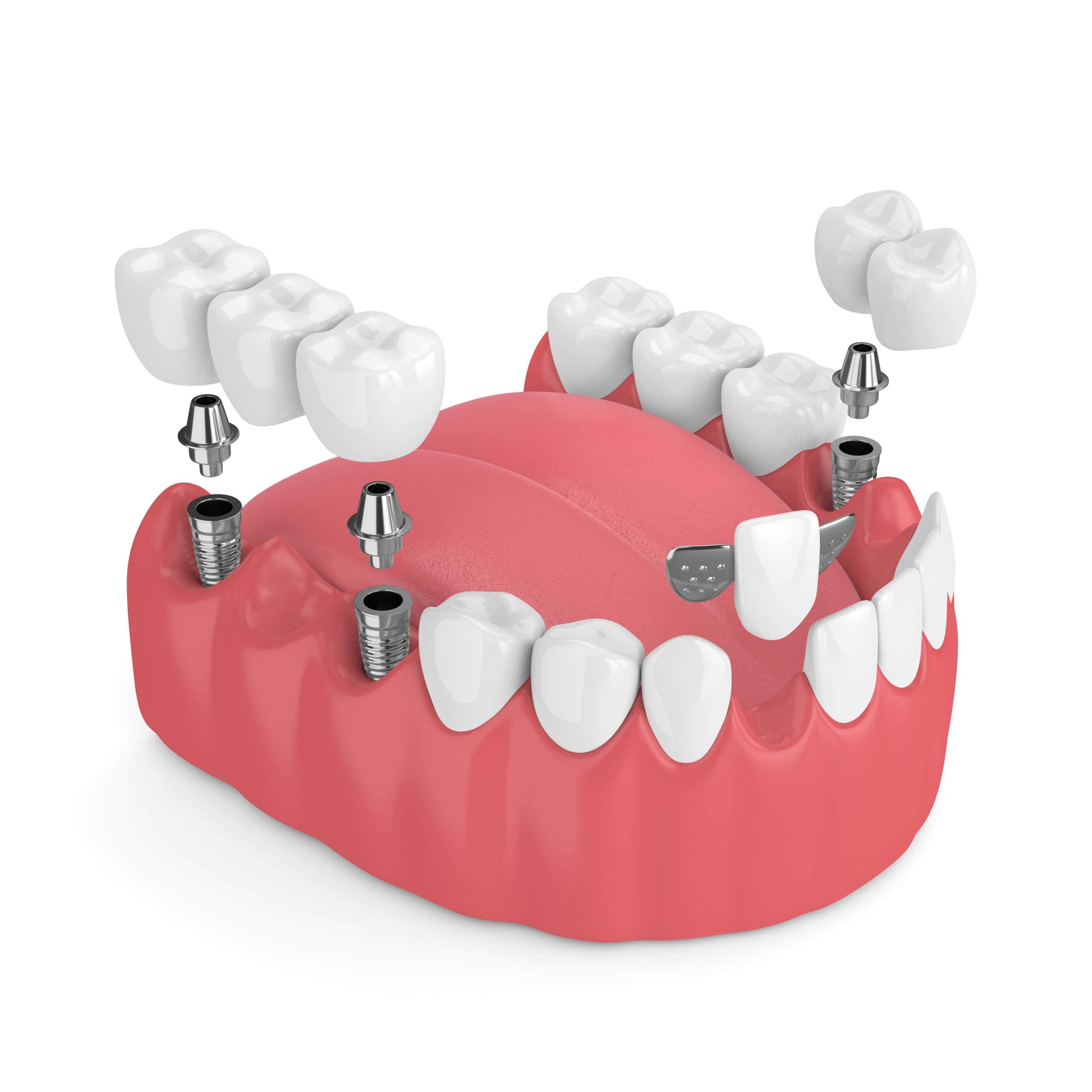Is a Dental Bridge Better than a Dental Implant?

Missing teeth can be problematic not just for the appearance of your smile but also for the functionality of your teeth when eating. There is also the potential for infection due to the space between the gums.
Extracting a tooth may be concerning that it may impact your day-to-day life. The good news is that your dentist can discuss the best options for you in order to protect your smile and mouth from the threat of missing teeth.
Rinaldi Dental Arts’ main focus is to help you to keep your natural teeth. When this is not possible, we are able to work with our patients to create a range of oral restoration services to give them back their smiles.
Benefits of Tooth Replacement
There are many reasons why a patient will want to choose to replace a missing tooth with a dental bridge or dental implant(s). A gap left in your mouth can create dental vulnerabilities and you may become susceptible to certain oral health issues. One of these health issues includes drifting teeth, leaving you with chronic jaw pain, and an uneven overbite. You may have a higher chance of developing periodontal (gum) disease due to the build-up of bacteria in areas of the mouth that can be hard to reach when brushing.
The replacement of missing teeth can also enhance your overall appearance. With quality design and craftsmanship, a natural-looking tooth replacement brings you a renewed confidence and willingness to show off that smile.
Here at Rinaldi Dental Arts in Chevy Chase, MD, just outside of Washington, DC, we work with you to create a customized tooth replacement solution suited to your time, budget, and overall oral health.
This post will look at two of the most common solutions—dental bridges and dental implants.

What is a Dental Bridge?
As the name implies, a dental bridge is an attachment that ‘bridges’ the gap between teeth that are missing using one or more artificial teeth. They sit naturally, and unlike dentures, are a more permanent option as the dentist bonds the bridge to the teeth to create a more secure fitting solution. A crown on either side of the bridge achieves this result.
They use one or more of the surrounding, healthy teeth, to create a support network to prevent issues with tooth alignment and bite in the future—as well as restoring the smile. Dental bridges are a good option to consider for those who are looking to replace one or more missing teeth. The bridge matches the overall appearance of your teeth because it is custom made and leaves you with a confident smile along with strong, functional teeth.
What are Dental Implants?
Similar to dental bridges, a dental implant is used to permanently replace missing teeth, creating natural results. However, unlike a bridge, implants are mock ‘roots’ using titanium posts surgically inserted into the jaw bone which then heals over several months. An artificial tooth called a crown attaches to the titanium post to complete the tooth.
A patient could receive one, several, or even a whole set of new teeth using natural-looking crowns that mimic real teeth. Having dental implants can improve the overall quality of life by offering a longer-lasting solution to your missing teeth. They also restore the function of your mouth and create a natural-looking confident smile.
Fitting a Dental Bridge
The treatment plan for fitting a dental bridge can vary depending on the solution Dr. Rinaldi offers. There are several stages to this dental procedure.
- Preparing the teeth: removing some of the enamel on the surrounding teeth allows space for the bridge
- Impressions: Dr. Rinaldi will make impressions of the teeth to ensure that the bridge is a comfortable fit for your mouth
- Color matching: to ensure a natural look, the new bridge is custom made to match the color of your remaining natural teeth
- Fitting: before the permanent fitting of the crown, Dr. Rinaldi ensures that the crown is a comfortable fit for you and your mouth
- Bonding: after any adjustments, the dentist bonds the bridge to the surrounding teeth to keep it in place
Dental Implant Procedure
These are the basic steps for receiving dental implants.
- Preparation of the implant area: Dr. Rinaldi may remove a tooth and several of the teeth from the surrounding area as necessary
- Insertion of the implant: Your dentist will use an implant made from biocompatible materials, which will fuse it to the bone and affix it in place
- Crown structure placed on implant: Dr. Rinaldi will decide whether a permanent (cemented in place) implant or a temporary crown will best suit you and your circumstances
- Recovery time: Dr. Rinaldi will recommend the types of foods and drinks you should and should not drink following this procedure, as well as the dental bridge procedure.
Now you have a greater understanding of what a dental bridge and a dental implant are, you should consider the pros and cons of each option to aid the decision-making process. Of course, our dedicated team of experienced dentists at Rinaldi Dental Arts in Chevy Chase, MD, will take the time to help you understand the pros and cons.
Pros and Cons of a Dental Bridge
Pros
- They are one of the more affordable options for replacing missing teeth.
- No bone grafting required if bone loss is present- this means that recovery time may be faster.
- They are a quicker option when it comes to replacing multiple missing teeth- the recovery time is likely to only take several weeks at the most.
Cons
- They can cause some strain on the surrounding teeth, particularly to those they are attached to.
- With an average of a 10-year expectancy, they are not a permanent solution to tooth loss.
- If patients do not follow the specific oral hygiene maintenance as advised by their dentists, this could cause further issues with their oral health.
Pros and Cons of Dental Implants
Pros
- Less of a burden on surrounding teeth. They also support surrounding teeth just like natural teeth would.
- Promote healing of surrounding bone and prevent bone loss.
- High-quality implants should last a lifetime and look and function like natural teeth.
Cons
- Can be an expensive treatment, particularly when many of the teeth need replacement.
- It may take several treatments to achieve the desired results.
- There is a longer healing time after the initial implant procedure.
For a consultation with a dedicated and highly experienced dental practitioner to discuss your tooth replacement solutions, contact the team at Rinaldi Dental Arts today! Dr. Rinaldi will go into further detail about each option to replace missing teeth.
